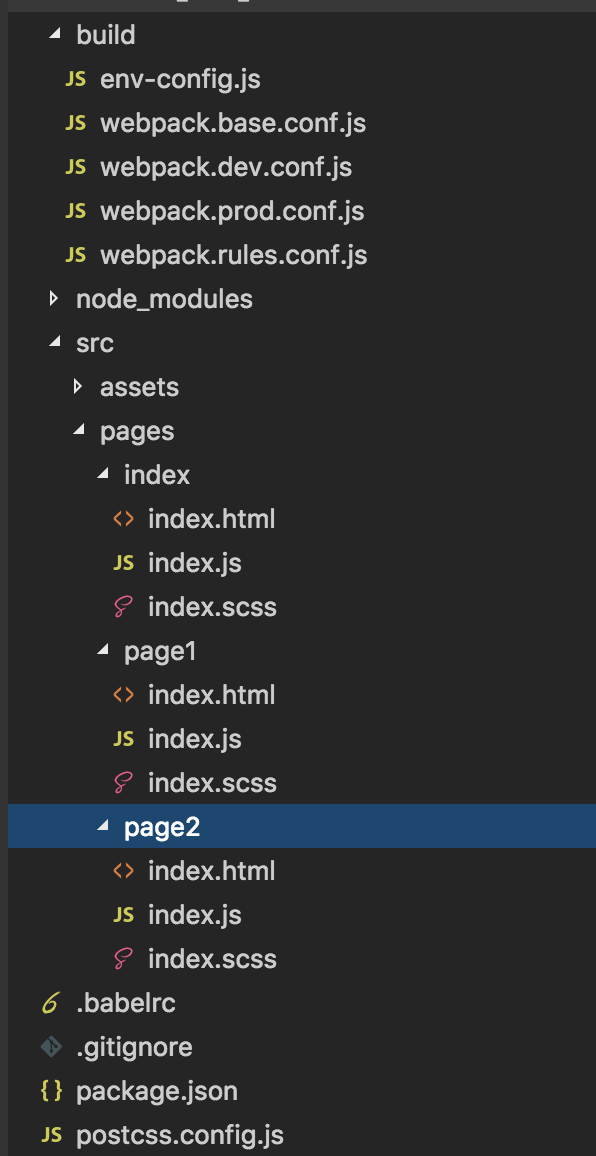项目需求制作为新的app的分享页,故需要制作多页面应用,那既然app是新的,这边我们也要更新上,经过多方考察(度娘)下,综合了一些他人的优点并结合项目实况产生了此文。
本文为了解释详细,篇幅可能会较长,并省去了部分初级操作。
ok,送上github地址 --- star,star,star我
项目目录:

既然是webpack4,那就主要解释下build中的文件
一. webpack.base.conf.js
公共配置文件:
const path = require('path');
const webpack = require("webpack");
const glob = require("glob");
require("./env-config");
// 分离css
//消除冗余的css
const purifyCssWebpack = require("purifycss-webpack");
// html模板
const htmlWebpackPlugin = require("html-webpack-plugin");
//静态资源输出
const copyWebpackPlugin = require("copy-webpack-plugin");
const rules = require("./webpack.rules.conf.js");
// 获取html-webpack-plugin参数的方法
var getHtmlConfig = function (name, chunks) {
return {
template: `./src/pages/${name}/index.html`,
filename: `${name}.html`,
// favicon: './favicon.ico',
// title: title,
inject: true,
hash: true, //开启hash ?[hash]
chunks: chunks,
minify: process.env.NODE_ENV === "development" ? false : {
removeComments: true, //移除HTML中的注释
collapseWhitespace: true, //折叠空白区域 也就是压缩代码
removeAttributeQuotes: true, //去除属性引用
},
};
};
function getEntry() {
var entry = {};
//读取src目录所有page入口
glob.sync('./src/pages/**/*.js')
.forEach(function (name) {
var start = name.indexOf('src/') + 4,
end = name.length - 3;
var eArr = [];
var n = name.slice(start, end);
n = n.slice(0, n.lastIndexOf('/')); //保存各个组件的入口
n = n.split('/')[1];
eArr.push(name);
entry[n] = eArr;
});
return entry;
};
module.exports = {
entry: getEntry(),
module: {
rules: [...rules]
},
resolve: {
alias: {
'@': path.resolve(__dirname, '../src')
}
},// 提取公共代码
optimization: {
splitChunks: {
cacheGroups: {
vendor: { // 抽离第三方插件
test: /node_modules/, // 指定是node_modules下的第三方包
chunks: 'initial',
name: 'vendor', // 打包后的文件名,任意命名
// 设置优先级,防止和自定义的公共代码提取时被覆盖,不进行打包
priority: 10
}
}
}
},
plugins: [//静态资源输出
new copyWebpackPlugin([{
from: path.resolve(__dirname, "../src/assets"),
to: './assets',
ignore: ['.*']
}]),
// 消除冗余的css代码
new purifyCssWebpack({
paths: glob.sync(path.join(__dirname, "../src/pages/*/*.html"))
}),
]
}
//配置页面
const entryObj = getEntry();
const htmlArray = [];
Object.keys(entryObj).forEach(element => {
htmlArray.push({
_html: element,
title: '',
chunks: ['vendor', element]
})
})
//自动生成html模板
htmlArray.forEach((element) => {
module.exports.plugins.push(new htmlWebpackPlugin(getHtmlConfig(element._html, element.chunks)));
})
虽然有注释,但是我还是会逐行解释下,是不是很贴心...…… ^_^
const path = require('path');
const webpack = require("webpack");
const glob = require("glob");
require("./env-config"); //暂时先不管它,后面会讲
// 分离css
//消除冗余的css
const purifyCssWebpack = require("purifycss-webpack");
// html模板
const htmlWebpackPlugin = require("html-webpack-plugin");
//静态资源输出
const copyWebpackPlugin = require("copy-webpack-plugin");
const rules = require("./webpack.rules.conf.js");
基本上就是一些变量的引用,简单解释一下glob和rules,glob是我们需要这个插件对我们多页面的路径做一个处理,这样我们打包后才会生成相应的多个文件,而rules则是一些loader的配置,大家直接引用就好,此处就不多讲了。
// 获取html-webpack-plugin参数的方法 var getHtmlConfig = function (name, chunks) { return { template: `./src/pages/${name}/index.html`, filename: `${name}.html`, // favicon: './favicon.ico', // title: title, inject: true, hash: true, //开启hash ?[hash] chunks: chunks, minify: process.env.NODE_ENV === "development" ? false : { removeComments: true, //移除HTML中的注释 collapseWhitespace: true, //折叠空白区域 也就是压缩代码 removeAttributeQuotes: true, //去除属性引用 }, }; }; function getEntry() { var entry = {}; //读取src目录所有page入口 glob.sync('./src/pages/**/*.js') .forEach(function (name) { var start = name.indexOf('src/') + 4, end = name.length - 3; var eArr = []; var n = name.slice(start, end); n = n.slice(0, n.lastIndexOf('/')); //保存各个组件的入口 n = n.split('/')[1]; eArr.push(name); entry[n] = eArr; }); return entry; };
这两个方法比较重要,因为当我们使用多页面打包的时候,在module.exports里的entry(此处所讲内容皆在此文件中,下面同样)中一般需要这样配置
module.exports = { entry: { index: './src/pages/index/index.js' , page1: './src/pages/index/page1.js' , page2: './src/pages/index/page2.js' } //下面暂时忽略 /*...*/ }
这样的话我们每添加一个文件就需要添加一项,页面少还好,当页面多了以后,无论是维护还是开发都很费劲,而且配置文件我们一般是不推荐做修改的。
而为了避免这样的操作,我们就需要去定义这两个方法来帮助我们
我们先来讲getEntry,它实际上就是获取到我们pages下各个页面的index.js,然后返回一个对象,这样我们就不用手动添加啦。
而getHtmlConfig则是用来配合htmlwebpackplugin的,htmlwebpackplugin需要一些配置,而我们是多页面应用就需要产出多个同配置但是不同名的html文件,这个方法就是用我们传入的参数而产生不同的页面名配置。
众所周知,在单页面应用中,我们只需要一个index.html就可以了,但是在多页面我们需要一一对应的页面,而去一个个new htmlwebpackplugin也违反了我们的初衷
//配置页面 const entryObj = getEntry(); const htmlArray = []; Object.keys(entryObj).forEach(element => { htmlArray.push({ _html: element, title: '', chunks: ['vendor', element] }) }) //自动生成html模板 htmlArray.forEach((element) => { module.exports.plugins.push(new htmlWebpackPlugin(getHtmlConfig(element._html, element.chunks))); })
我们的页面是有规律的,也就是index.js对应相应的index.html,那我们就可以利用之前的getEntry来获取到js文件,在生成对应的数组,利用gethtmlconfig,放入htmlwebpackplugin中就可以了。
二. webpack.dev.conf.js
开发环境配置文件:
const path = require('path');
const webpack = require("webpack");
const merge = require("webpack-merge");
const webpackConfigBase = require('./webpack.base.conf');
const webpackConfigDev = {
mode: 'development', // 通过 mode 声明开发环境
output: {
path: path.resolve(__dirname, '../dist'),
// 打包多出口文件
filename: './js/[name].bundle.js'
},
devServer: {
contentBase: path.join(__dirname, "../src"),
publicPath:'/',
host: "127.0.0.1",
port: "8090",
overlay: true, // 浏览器页面上显示错误
// open: true, // 开启浏览器
// stats: "errors-only", //stats: "errors-only"表示只打印错误:
hot: true, // 开启热更新
//服务器代理配置项
proxy: {
'/test/*':{
target: 'https://www.baidu.com',
secure: true,
changeOrigin: true
}
}
},
plugins: [
//热更新
new webpack.HotModuleReplacementPlugin(),
new webpack.DefinePlugin({
'process.env.BASE_URL': '"' + process.env.BASE_URL + '"'
})
],
devtool: "source-map", // 开启调试模式
}
module.exports = merge(webpackConfigBase, webpackConfigDev);
引入所需
webpack-merge,用来合并我们的webpack.base.conf.js和webpack.dev.conf.js
proxy,因为我们启动dev环境的话,是在本地调试,会出现跨域的问题,proxy为我们做一层代理,解决跨域难题。
webpack.DefinePlugin, 后面我们在讲
三. webpack.prod.conf.js
生产环境配置文件:
const path = require('path');
const webpack = require("webpack");
const merge = require("webpack-merge");
// 清除目录等
const cleanWebpackPlugin = require("clean-webpack-plugin");
const UglifyJSPlugin = require('uglifyjs-webpack-plugin');
const BundleAnalyzerPlugin = require('webpack-bundle-analyzer').BundleAnalyzerPlugin;
const OptimizeCSSPlugin = require('optimize-css-assets-webpack-plugin')
const extractTextPlugin = require("extract-text-webpack-plugin");
const webpackConfigBase = require('./webpack.base.conf');
process.env.NODE_ENV = "test"
const webpackConfigProd = {
mode: 'production', // 通过 mode 声明生产环境
output: {
path: path.resolve(__dirname, '../dist'),
// 打包多出口文件
filename: './js/[name].[hash].js',
publicPath: './'
},
devtool: 'cheap-module-eval-source-map',
plugins: [
//删除dist目录
new cleanWebpackPlugin(['dist'], {
root: path.resolve(__dirname, '../'), //根目录
// verbose Write logs to console.
verbose: true, //开启在控制台输出信息
// dry Use boolean "true" to test/emulate delete. (will not remove files).
// Default: false - remove files
dry: false,
}),
new webpack.DefinePlugin({
'process.env.BASE_URL': '"' + process.env.BASE_URL + '"'
}),
// 分离css插件参数为提取出去的路径
new extractTextPlugin({
filename: 'css/[name].[hash:8].min.css',
}),
//压缩css
new OptimizeCSSPlugin({
cssProcessorOptions: {
safe: true
}
}),
//上线压缩 去除console等信息webpack4.x之后去除了webpack.optimize.UglifyJsPlugin
new UglifyJSPlugin({
uglifyOptions: {
compress: {
warnings: false,
drop_debugger: false,
drop_console: true
}
}
})
],
module: {
rules: []
},
}
module.exports = merge(webpackConfigBase, webpackConfigProd);
引入所需
cleanWebpackPlugin, 我们每次build后都会产出许多不同名文件(hash不同),但我们是不需要之前的文件的,利用这个插件来清除掉我们之前的dist文件
好了,这两个文件比较简单,就不多解释了...
四. env-config.js
一般情况下,我们配置到这个地步就已经可以使用了,但因为项目需求我们需要配置超过2个的环境变量(webpack默认两个development和production)
而我们不同的环境可能需要不同的接口:
ps: text ---> 请求test-api ,
dev ---> 请求dev-api,
pro ---> 请求api,
...
这时我们就需要利用前面所没有讲的webpack.DefinePlugin了,这个插件是用来声明全局变量的,我们依据不同的打包命令定义不同的接口名称。
'use strict' const path = require('path') /* * 环境列表,第一个环境为默认环境 * envName: 指明现在使用的环境 * dirName: 打包的路径,只在build的时候有用 * baseUrl: 这个环境下面的api 请求的域名 * assetsPublicPath: 静态资源存放的域名,未指定则使用相对路径 * */ const ENV_LIST = [ { //开发环境 envName: 'dev', dirName: 'dev', baseUrl: 'http://100.xxx.xxx', assetsPublicPath:'/' }, { //测试环境 envName: 'test', dirName: path.resolve(__dirname, '../dist'), baseUrl: 'http://111.xxx.xxx', assetsPublicPath: '/' }, { //生产环境(命令行参数(process.arg)中prod是保留字,所以使用pro) envName: 'pro', dirName: path.resolve(__dirname, '../dist'), baseUrl: 'http://122.xxx.xxx', assetsPublicPath:'/' }, ] const argv = JSON.parse(process.env.npm_config_argv).original || process.argv const HOST_ENV = argv[2] ? argv[2].replace(/[^a-z]+/ig,"") : '' //没有设置环境,则默认为第一个 const HOST_CONF = HOST_ENV ? ENV_LIST.find(item => item.envName === HOST_ENV) : ENV_LIST[0] // 把环境常量挂载到process.env方便客户端使用 process.env.BASE_URL = HOST_CONF.baseUrl // process.env.ENV_NAME = HOST_CONF.envName module.exports.HOST_CONF = HOST_CONF module.exports.ENV_LIST = ENV_LIST
我们声明一个数组,里面用来存放我们的环境变量,在将获取到的环境变量挂载到process.env上,如我所写的话,我们在客户端直接console.log(process.env.BASE_URL)就是当前环境了。
那么程序怎么知道我们打包的是哪个环境呢?那就要去package.json中去做文章了
"scripts": { "test": "npm run build --[test]", "dev": "cross-env NODE_ENV=development webpack-dev-server --config build/webpack.dev.conf.js", "build": "cross-env NODE_ENV=production webpack --config build/webpack.prod.conf.js" },
这里我只做了test环境的配置,其他的只要配置npm run build --[xxx]即可,这里提醒一点,dev和build个人觉得其实不应该算是两个环境变量,应该是你打包的手段(原谅我只能这样解释),你可以理解为一个是debug环境,一个是上线环境。
而前面没有说的其实就是webpack.base.config.js引入我们的变量,而dev和prod中在去将我们需要的变量声明全局啦。
ok,到这里基本就可以快乐的编写你的页面啦。
结束啦~结束啦~...